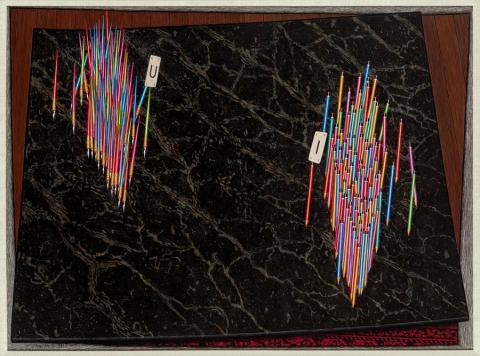U AND I, 1983-84
JOHN BRACK
oil on canvas
97.0 x 130.0 cm
signed and dated lower left: John Brack 1983/84
Tolarno Galleries, Melbourne
Private collection, Sydney, acquired from the above in 1985
John Brack, Tolarno Galleries, Melbourne, 21 September – 12 October, 1985
John Brack, A Retrospective Exhibition, National Gallery of Victoria, Melbourne, 10 December 1987 – 31 January 1988, cat. 108
Art and Australia, vol. 23, no. 3, 1986, p. 325 (illus.)
Lindsay, R., John Brack: A Retrospective Exhibition, National Gallery of Victoria, Melbourne, 1987, pp. 135, 141, p. 86 (illus.)
Grishin, S., The Art of John Brack, Oxford University Press, Melbourne, 1990, vol. I, pp. 164–165, pl. 52 (illus.) and vol. II, cat. o277, p. 37
'Gradually I became conscious that if I am looking at the world, then I am looking at it from a great distance both in place and time. Gradually I came to look at the world physically from a long way away and also in terms of time from a long way away. The general meant doing the whole thing - the thing had to be a summing up in a general way. You pick up the thing nearest to hand, the pencil, and that represents the visual metaphor.'1
The greatest artists frequently take the simplest of everyday items from their environment and transform a basic implement into something deeply significant that reveals greater truths about the world. John Brack's 'Pencil series', often referred to as battles, are a great 'summing-up' of the world and humanity. In one instance this group of works painted between 1978 and 1986 are deeply introspective visions of the artist's own reclusive painting practices, focusing as they do on his immediate materials. More significantly, they are a meditation on social organisation and society's propensity to arrange itself along ideological, cultural, sexual, political or any other such lines into fortified groups or tribes. In the arrangement of his pencils and pens Brack transforms them into a metaphor of opposing forces. As Grishin points out in his essay on the 'Battle' paintings, 'Once a grouping has formed, then rivalry and opposition seem inevitable.'2 In U and I, Brack balances scrabble letters each of unequal value, amidst the advance guard of the pencils and pens instilling the work with an unequivocal sense of combat and division. The power and tension in this painting resides in the fact that the pens and pencils seem so tightly formed as though on the cusp of an assault.
Brack had been an artillery officer during World War II but found a realistic rendering of the savagery of war insufficient in bringing us close to understanding human conflict and referred to classical depictions of battle scenes as a 'slow ballet'. On reflecting upon old soldiers he once commented, 'When those old gentlemen refought their battles they picked up their knives and forks and salt-cellars and used them to represent the lines of troops, the pill-boxes. My pens and pencils are the same thing. They're the things I draw with; they're the things I use.'3 While we are lured in to view the detail in Brack's battle scenes, the extreme perspective and the seemingly incidental edge of the Persian carpet bordering the scene, take us back to the 'summing up' and the realisation of the futility of conflict and the banality of our day-to-day battles.
1. John Brack interview with Sascha Grishin, 6 December 1988, quoted in Grishin, S., The Art of John Brack, Oxford University Press, Melbourne, 1990, vol. I, p. 145
2. Ibid, p. 146
3. Ibid, p. 152
LARA NICHOLLS
